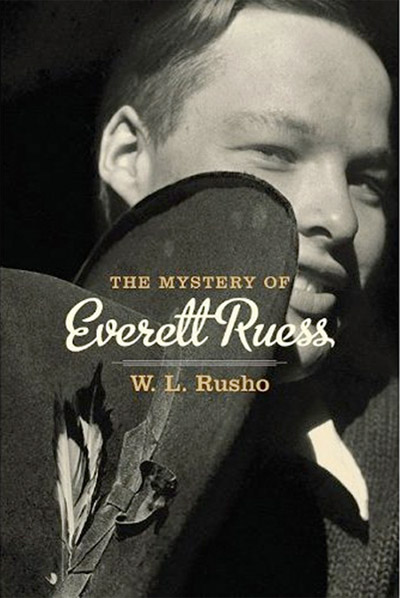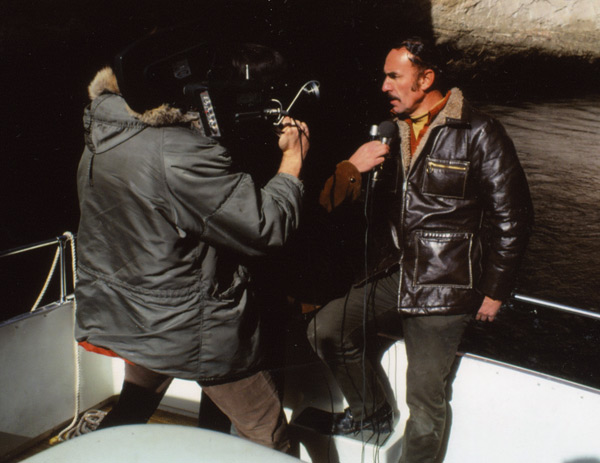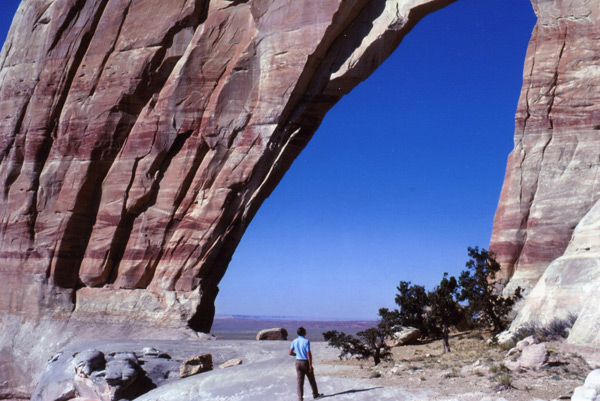The Mystery of Everett Ruess: An Interview with W. L. Rusho
 Thursday, January 6, 2011 at 10:22PM Tweet
Thursday, January 6, 2011 at 10:22PM Tweet  Image courtesy The Mystery of Everett Ruess, Gibbs Smith Publisher
Image courtesy The Mystery of Everett Ruess, Gibbs Smith Publisher
You initially started your research on Everett Ruess nearly thirty years ago. What gave you the idea for the initial book and why this topic?
The story of Everett Ruess grew out of my research of the history of Glen Canyon before Lake Powell. I learned of Ruess when Greg Crampton got a letter from Waldo Ruess asking if Greg—as principal history researcher for the Glen Canyon Salvage Project—had learned anything about the disappearance of his brother, Everett. Greg had found nothing useful, but he informed me of the letter. Intrigued, I bought a used copy of “On Desert Trails” published in 1940 that included many of Everett’s letters and poems, and that speculated on his disappearance from Davis Gulch in the winter of 1934-35.
 KSL interview with Bud Rusho at Lake Powell. Photo courtesy of Bud Rusho.
KSL interview with Bud Rusho at Lake Powell. Photo courtesy of Bud Rusho.
Then in 1982, Gibbs Smith told me that he had acquired, from Waldo, the rights to edit and republish Everett’s letters and poems, and Gibbs asked me to edit the volume. I was, of course, happy to do so.
How long did it take you to research and compile the book?
I only worked on the material for about a year, as the “Vagabond for Beauty” was published in Oct. 1983. During that time I carefully culled through the Ruess material, and Gibbs and I made a trips to Escalante and Davis Gulch. We also made a long trip to Alamos, Mexico, to interview a witness who had met Everett Ruess. I should have also retraced Everett’s earlier travels in California and Arizona, but Gibbs’ budget would not support such a trip.
 Bud Rusho at White Mesa Arch, Arizona. Photo courtesy of Bud Rusho.
Bud Rusho at White Mesa Arch, Arizona. Photo courtesy of Bud Rusho.
Who, among the many people you interviewed, was the most intriguing personality?
Probably the most interesting were three people who had actually known Everett briefly—Tad Nichols and Clayborn Lockett in Tucson, and Randolph Jenks in Alamos, Mexico. They didn’t know much about Everett, but each of them was an artist in himself, having collected, painted, or photographed the Red Rock country.
What was the most interesting ‘behind the scenes’ story?
Why were Everett’s possessions—sleeping bag, food, clothing, diary—missing when the burros were discovered in February 1935? They were probably stolen, either by a Navajo who killed Everett—improbable—or by Gail Bailey from Escalante, a rancher who was first on the scene. Bailey steadfastly denied having seen the possessions, but he admitted to taking the burros and their harnesses. The lack of possessions has clouded all speculations on Everett’s disappearance.
Describe the biggest challenge you experienced since the books have been published.
Are we talking about the original book Everett Ruess—Vagabond for Beauty or it’s newer reincarnation The Mystery of Everett Ruess? For the original book, my biggest difficulty, in 1982, was having to work on an old Royal typewriter, thus having to type the manuscript several times. Also, Gibbs Smith was tight with funds, thus restricting my research. And the Gibbs Smith editor, a guy named Buckley, cut out large portions of material that I considered good writing.
With the newer book, The Mystery, I have had only pleasant experiences with Gibbs and his editor, Madge Baird. The book is more attractive, especially with larger photos. Of course, it could have been better with an ample research budget, but it’s a good compromise.
What are your most rewarding experiences since the books have been published?
The book has been successful—not a blockbuster—but it has been attracting readers of many ages, and has always been in print. The newer book, The Mystery of Everett Ruess, has received good reviews, but is essentially old news. So I don’t know how it will fare, especially since two writers are coming out with Everett Ruess bios in 2011 and 2012.
What is the most commonly asked question that you get and what is your answer?
Naturally, the first question is “What do you think happened to Everett?” This is really the heart of the whole Everett phenomena. Without the disappearance in 1935 (and his mother’s persistent efforts to get his letters published), the world would have forgotten the guy. In 2009, I was confused by reports—later proved wrong—that Everett’s body had been discovered in Comb Ridge, as evidenced by DNA tests. I always found that hard to believe, so I was relieved when the bones were found to be that of a Navajo. I personally believe that Everett, while climbing around, fell to his death into a narrow slot canyon, a canyon that could not be reached by the 1935 horseback searchers. Yet the mystery remains, which is vital for the story to live on.
 Everett Ruess,
Everett Ruess,  Utah,
Utah,  W. L. Rusho | in
W. L. Rusho | in  Books,
Books,  My-West.com,
My-West.com,  Writers Camp
Writers Camp 
Reader Comments